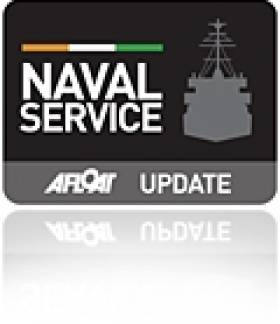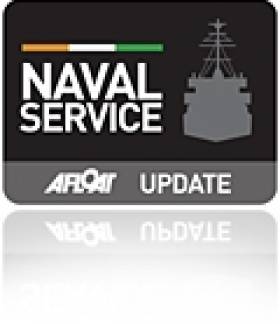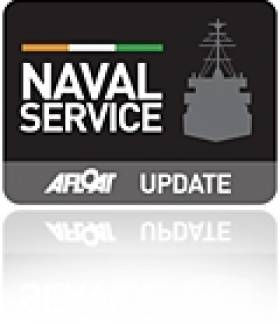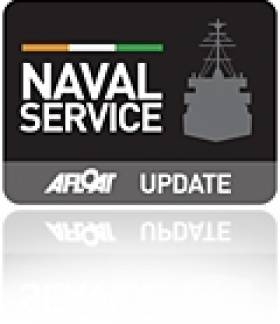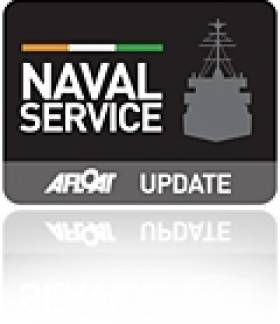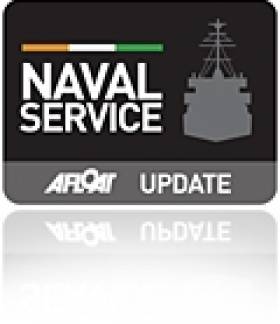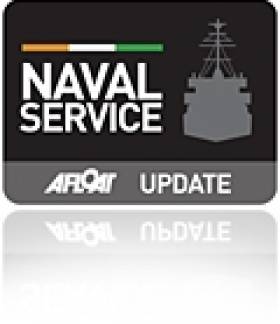Displaying items by tag: Navy
Commodore Liam 'Willie' Brett R.I.P. 1929 - 2015
The death has taken place of Commodore (Retired) Liam Brett, former Flag Officer Commanding the Naval Service. Commodore Brett was instrumental in the expansion of the Naval Service beginning with the L.É. DEIRDRE in the early 1970s.
He was pivotal in the operations to detain the "Claudia" and the "Marita Anne" IRA gun running ships in the 70s and 80s, and also the Aer Lingus Viscount and the Air India recovery operations in his earlier years before commanding the Naval Service as Flag Officer until 1990.
He retired from the Naval Service after a 44 year career and is survived by his four children, son in law and five grand children.
Ireland to Make Donation of Former OPV 'Aoife' to Malta
#AoifeDonation - On the margins of an EU Defence Ministers informal meeting in Riga, Latvia, Minister for Defence, Mr. Simon Coveney, T.D. met Mr. Carmelo Abela, Minister for Home Affairs and National Security of Malta on Wednesday.
According to the Gozo News, as well as discussing the EU Defence agenda, the Ministers reviewed the continuing cooperation between Malta and the Republic of Ireland on Defence matters.
This included the training of Maltese personnel in Ireland and future potential operations cooperation, building on the successful joint training team Malta and Ireland provided to the EU Training Mission in Somalia. The Minister agreed to explore further prospects for cooperation.
In this context the Ministers agreed to transfer ownership of the LÉ Aoife to the Maltese Armed Forces. The LÉ Aoife (P22) was decommissioned as previously reported on Afloat.ie last month following 35 years of operational service.
While the vessel is no longer viable for use in Irish waters it is ideally suited to address a pressing short-term shortfall in the naval capacity of Malta.
To read more as to the reasons to transfer the former Irish OPV to the Mediterranean, click the report HERE.
Factory Trawlers off Blaskets Detained by Naval Service
#FactoryTrawlers –L.E. Samuel Beckett (P61) the newest Naval Service OPV has according to RTE News detained two British-registered factory trawlers for alleged breaches of fisheries legislation today.
The trawlers were detained in a joint operation with the Sea Fisheries Protection Agency, 30 miles west of the Blasket Islands. The trawlers were fishing for pelagic species, such as mackerel.
LE Samuel Beckett is the Naval Service's newest ship and the trawlers are among the biggest vessels boarded by the Naval Service over the past year, each being 55 metres long.
Both trawlers are being escorted to Cobh, Co Cork and are due to arrive Thursday evening.
LE Samuel Beckett was commissioned for service in May 2014 as previously reported on Afloat.ie with coverage of her first patrol following her naming ceremony in Dublin Dublin Port.
Naval Service’s Longest Serving Vessel L.É. Aoife Decommissioned
#Decommissioned – Naval Service OPV LÉ Aoife (P22), the longest-serving vessel in the fleet has been decommissioned at a special ceremony yesterday in Waterford City, reports RTE News.
In 35 years of service to the State she travelled in excess of 600,000 nautical miles, an equivalent of circumnavigating the globe 28 times, and her crew has boarded over 4,700 vessels at sea and detained over 440 fishing vessels.
During her service L.É Aoife was involved in numerous successful operations, primarily involving her role as a fishery protection vessel, but also search and rescue missions, most notably, the recovery in 1985 of the black box from Air India Flight 182 off the south west coast.
She departed Dublin Port on a farewell call during the week to her adopted homeport where the decommissioning ceremony took place. For more coverage by RTE click HERE.
Afloat.ie adds like her predecessor, L.E. Emer (P21) sold at auction in 2013, they were deployed on re-supply missions to Irish troops serving overseas with the United Nations in particular Lebanon.
The second of a trio of 'Emer' class offshore patrol vessels (OPV) she was built by Verolme Cork Dockyard and each of the 65m OPV's had a crew compliment of 46 (5 officers).
Now that the 'Aoife' has bowed out this leaves L.E. Aisling (P23) as the surviving sister to soldier on in the current reduced fleet of seven ships.
A pair of replacement newbuilds of the OPV90 'Beckett' class are on contract from Babcock Marine in the UK.
A date for Aoife's auction has yet to be confirmed. Her successor James Joyce is due for delivery in March this year.
The final and as yet to be announced name for the third newbuild is to enter service in 2016.
L.É. Aoife Makes Final Farewell Visit to Dublin Port
#FarewellDublin – Naval Service OPV L.É. Aoife (P22) departed Cork Harbour to make an overnight final farewell visit to Dublin Port before the OPV's decommissioning in Waterford this Saturday, writes Jehan Ashmore.
Her arrival to the capital close to last midnight had echoed that of leadship offshore patrol vessel sister, L.É. Emer (P21) which also berthed on the Liffey in 2013. She was sold at auction in 2013 to Nigerian interests.
Unlike her predecessor's Dublin farewell visit, L.É. Aoife in comparison made a shorter call.
The call was less than 24 hours and in which saw the 65m OPV berth at Sir John Rogerson's Quay. No doubt the historic naval occasion was marked to highlight a career spanning 35 years since her entry into service during November 1979.
At lunchtime L.E. Aoife departed the port and also bid Dublin Bay farewell for the last time in blustery conditions.
She set a course to pass Dalkey Island. From offshore of that coastal suburb and the Muglins Lighthouse, she continued on the coastal shipping lane bound for the south-eastern inland port.
Waterford City is the adopted homeport of L.É. Aoife and as reported yesterday, the Suir will set an appropriate scene for Saturday's afternoon decommissioning ceremony.
L.É. Aoife Only Days Before Decommissioning
#Decommission - L.É Aoife (P22), the Naval Service's oldest vessel as previously reported on Afloat.ie is on her last patrol before decommissioning with a date now confirmed for next Saturday 31 January, writes Jehan Ashmore.
Waterford City is where the Verolme Cork Dockyard built offshore patrol vessel (OPV) will be decommissioned ceremonially. The choice of location is apt given that L.É Aoife's adopted homeport is that of the inland south-eastern city-port.
She was launched in 1978 following leadship class 'Emer' an improved version of L.É Deirdre, long since sold. The 65m OPV was named Aoife, stepmother to the children of Lir, whom she turned into swans. She entered the Naval Service when commissioned in November 1979.
A timeframe, for the OPV's disposal through a public auction (if not previously sold) remains to be confirmed according to the Department of Defence spokesperson. However, the auctioneer's website still suggests otherwise with an auction date to be held sometime in February, for details and further updates, click HERE.
Yesterday, L.É Aoife departed Cork Harbour from where the navy's pair of coastal patrol vessels CPV's as reported on Afloat.ie have been out of service due to work to remove asbestos.
As for the direct replacement of L.É Aoife, newbuild, James Joyce is understood to be scheduled to carry out sea acceptance trials in mid-February.
She is the second of a trio of OPV90 class 'Beckett' newbuilds totalling €162m that have been ordered in a contract to Babcock Marine's Devon shipyard in Appledore.
Naval Service Patrol Vessels Undergo €350,000 Asbestos Removal Works
#Asbestos- A Department of Defence spokesperson has confirmed to Afloat.ie, that the Naval Service pair of coastal patrol vessels (CPV) have been cleared of airborne asbestos and that the dangerous material was in engine room spaces, writes Jehan Ashmore.
As previously reported on Afloat.ie, the hazardous asbestos was discovered last year on board the CPV L.É Ciara (P42), which led to claims over health concerns to her crew and civilians workers.
The overall cost of the asbestos clearance which includes her sister L.É Orla (P41) is according to the Department to be in the region of €350,000 and not the speculated €1m as reported by Ships Monthly.
The sisters were given the all-clear for asbestos back in 2000, following a survey conducted by a now defunct consultancy firm.
In addition according to the UK publication, the asbestos in the engine room was used for lagging purposes by shipbuildersin 1984, Hall Russell & Co of Aberdeen (since closed) which completed the pair for the Royal Navy as part of a larger order.
Four years later the 'Peacock' class twins that served the RN's Hong Kong Patrol Squadron where transferred to the Naval Service in 1988. That same year, I recall making a visit to board the CPVs which had recently arrived in the naval basin in Cork Harbour, where they moored abreast.
In the following year, An Taoiseach Charles J. Haughey officially commissioned them into service.
The Department of Defence have also informed Afloat.ie that the 'Orla' the former HMS Swift (P241) and 'Ciara' as the Swallow (P242) are currently having remedial work done on the funnels, cranes and air-handling units.
In addition the CPV's have undergone a "normal" refit work, which was carried out at Cork Dockyard and the department added to Afloat.ie, that the maintenance dry-docking was scheduled before the asbestos issue arose.
The vessels are also understood to have returned today (or early February) to the Naval Base on Haulbowline Island, from where further work is to continue.
At present, L.É Orla is scheduled to undergo sea acceptance testing in mid-February and it is expected that L.É Ciara will follow suit when available in March.
Bid by Elite Seamen to Pass Gruelling Naval Diving Test
#EliteDiving - As the country was battening down the hatches and ducking for cover this week, 10 hardy hopefuls took to the icy waters of Cork harbour, writes The Irish Mirror.
Standing to attention in gale force winds on Haulbowline Pier, this wasn't some cheap TV reality series designed to make us all feel fat.
There were no camera-friendly emotional breakdowns or interesting back stories.
No, these are the elite seamen vying for a coveted place on the Naval Services Diving Section.
What awaits those who succeed is not fame and fortune. Instead they will be expected to leave important family events at a moment's notice to recover bodies or tackle dangerous underwater bombs.
Each year around 50 people apply and roughly 15 of these are selected for the gruelling 11-week course.
For much more on this story, click HERE.
#OPVJamesJoyce – L.É. Aoife (P22) is on her last patrol before decommissioning and direct replacement newbuild, James Joyce is scheduled to carry out sea acceptance trials in mid-February, writes Jehan Ashmore.
According to the Department of Defence, should the second OPV90 ‘Beckett’ class proceed with sea-trials as scheduled, the newest addition to the Naval Service should make her delivery voyage to Irish waters in March.
The Department added that the formal commissioning date for the £54m offshore patrol vessel will be arranged when the ship arrives in Ireland. She is 90m in length, with a top speed of 23 knots and will have a range of 6,000 nautical miles.
As Afloat.ie previously reported, her sister leadship, L.E. Beckett (P61) undertook sea trials in the Bristol Channel prior to her delivery voyage with a first arrival to Cork Harbour last April.
James Joyce was floated-out in November from the shipbuilding hall of Babcock Marine & Technology. The yard is located on the banks of the River Torridge, Appledore in north Devon.
She is to be followed by a third sister in which no name has been chosen so far. This final OPV90 is to enter service in 2016.
L.É. Aoife Carrying Out Final Patrol to End This January
,#FinalPatrol - L.É. Aoife (P22) the oldest Naval Service vessel is currently on her final patrol before she bows out of her career, which is expected to end within the final week of January, writes Jehan Ashmore.
Afloat.ie has contacted the Department of Defence which at this stage cannot confirm details of her official decommissioning. A Naval Service source, however, suggests that she may be decommissioned ceremonially also later this month, in Waterford, her adopted homeport.
Following that, a timeframe for the OPV’s disposal by public auction (if not previously sold) is understood to be held in either late February or early March, though this remains to be confirmed.
The OPV built at Verolme Cork Dockyard is the second of a trio of 'Emer' class sisters. They were an improved version of the original ‘Deirdre’ class launched in 1972 and also completed by the same shipyard.
As for the removal of her armaments, the Department of Defence said these matters are being considered as part of the decommissioning process.
Viewings of the L.É. Aoife, can be made strictly by appointment only, to contact Dominic J. Daly call on 087 2550486 and for further developments, click the auctioneer's website, HERE.
Directly replacing the veteran vessel is the OPV90 class newbuild, L.É. James Joyce, which as previously reported is the second of the trio of ‘Beckett’ class ordered from Babcock Marine.
She was floated-out last November at their shipyard facility in Appledore, north Devon.



























